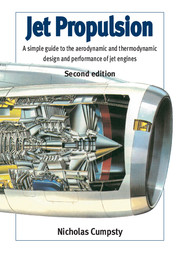 Jet Propulsion
Jet Propulsion Book contents
- Frontmatter
- Contents
- Preface
- Glossary
- Nomenclature
- Part 1 Design of Engines for a New 600-seat Aircraft
- 1 The New Large Aircraft – Requirements and Background
- 2 The Aerodynamics of the Aircraft
- 3 The Creation of Thrust in a Jet Engine
- 4 The Gas Turbine Cycle
- 5 The Principle and Layout of Jet Engines
- 6 Elementary Fluid Mechanics of Compressible Gases
- 7 Selection of Bypass Ratio
- 8 Dynamic Scaling and Dimensional Analysis
- 9 Turbomachinery: Compressors and Turbines
- 10 Overview of the Civil Engine Design
- Part 2 Engine Component Characteristics and Engine Matching
- Part 3 Design of Engines for a New Fighter Aircraft
- Part 4 Return to the Civil Transport Engine
- Appendix: Noise and its Regulation
- Bibliography
- References
- Index
- Design sheets for New Large Civil Aircraft and New Fighter Aircraft
9 - Turbomachinery: Compressors and Turbines
from Part 1 - Design of Engines for a New 600-seat Aircraft
- Frontmatter
- Contents
- Preface
- Glossary
- Nomenclature
- Part 1 Design of Engines for a New 600-seat Aircraft
- 1 The New Large Aircraft – Requirements and Background
- 2 The Aerodynamics of the Aircraft
- 3 The Creation of Thrust in a Jet Engine
- 4 The Gas Turbine Cycle
- 5 The Principle and Layout of Jet Engines
- 6 Elementary Fluid Mechanics of Compressible Gases
- 7 Selection of Bypass Ratio
- 8 Dynamic Scaling and Dimensional Analysis
- 9 Turbomachinery: Compressors and Turbines
- 10 Overview of the Civil Engine Design
- Part 2 Engine Component Characteristics and Engine Matching
- Part 3 Design of Engines for a New Fighter Aircraft
- Part 4 Return to the Civil Transport Engine
- Appendix: Noise and its Regulation
- Bibliography
- References
- Index
- Design sheets for New Large Civil Aircraft and New Fighter Aircraft
Summary
INTRODUCTION
The compressor, which raises the pressure of the air before combustion, and the turbine, which extracts work from the hot pressurised combustion products, are at the very heart of the engine. Up to now we have assumed that it is possible to construct a suitable compressor and turbine without giving any attention to how this might be done. In this chapter an elementary treatment is given with the emphasis being to find the overall diameter of various components and the flow-path this entails, the number of stages of compressor and turbine, and suitable rotational speeds. The details of blade shape will not be addressed. Further information is obtainable at an elementary level in Dixon (1995) and at a more advanced level in Cumpsty (1989).
For the large engine that we are considering the most suitable compressor and turbine will be of the axial type. These are machines for which the flow is predominantly in the axial and tangential directions, and stand in contrast to radial machines for which the flow is radial at inlet or outlet.
Because the pressure rises in the direction of flow for the compressor there is always a great risk of the boundary layers separating, and when this happens the performance of the compressor drops precipitously and is said to stall. To obtain a large pressure rise (or, as it is more commonly expressed, pressure ratio) the compression is spread over a large number of stages.
- Type
- Chapter
- Information
- Jet PropulsionA Simple Guide to the Aerodynamic and Thermodynamic Design and Performance of Jet Engines, pp. 94 - 107Publisher: Cambridge University PressPrint publication year: 2003


